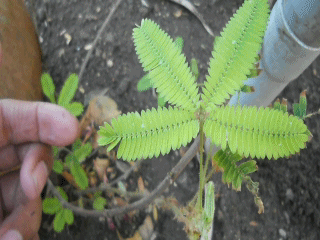- Some plants, such as the vines of a burr cucumber are far more sensitive - up to 10 times as sensitive. In fact four, e will see why this can be so important for plants.
- Plants, such as the venus flytrap, use touch to know when to close their traps. To trigger the trap takes two hairs to be touched within 20 seconds.
- Plants such as the sensitive plant (Mimosa pudica) react to touch by closing themselves up. Some explanations for this include the plant attempting to remove insects from its leaves, or that herbivores may not want to eat a 'moving' plant and will move on to a plant that remains still while being eaten.
- Other plants die when they've been touched. This can be beneficial to the plant as it will prefer to grow away from anything that will hinder its growth. Stresses such as wind, different types of precipitation and animal contact can change how a plant grows. An experiment on the Arabidopsis thaliana showed that just stroking the leaves just a few times each day will render the plant squatter and delay flowering than one that was left alone.
- As with us animals, plants utilise electrical charges to register touch. The movement of electrical flow within the plant can warn the rest of the plant about any current danger. An example of this was an experiment with a tomato plant by Dianna Bowles. She iced the petiole to block any chemical flow from the leaf to the stem. This doesn't stop the electrical flow, which was used to warn the rest of the plant about the danger it was under (in this case hot metal on the leaf).
Chamovitz, D. (2012) What a Plant Knows, Oxford, Oneworld Book.
http://en.wikipedia.org/wiki/File:Mimosa_Pudica.gif


No comments:
Post a Comment
I really enjoy reading and replying to your comments, but please do not use this space for advertising!